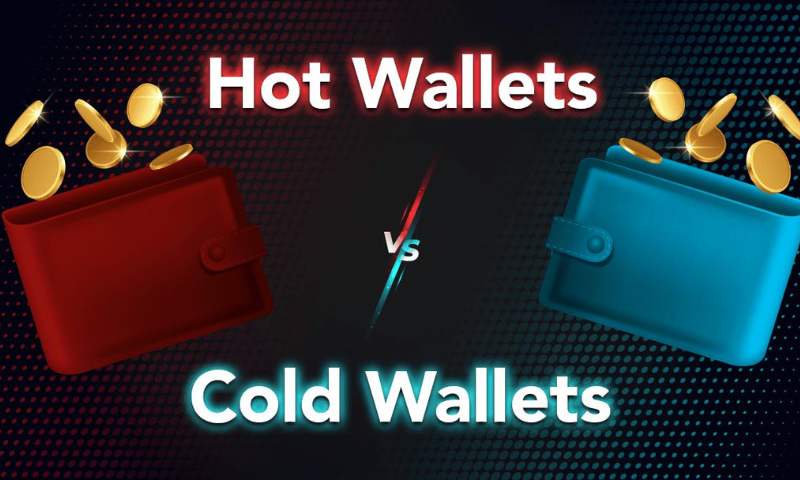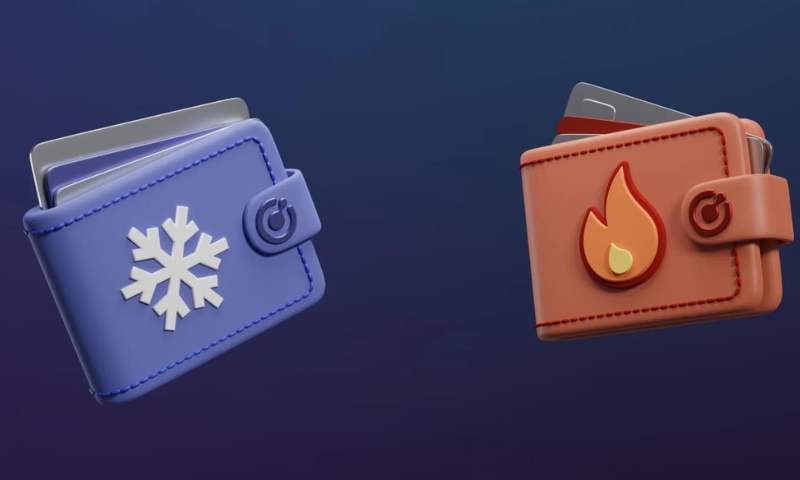Diving into the world of cryptocurrency can feel like exploring a digital Wild West, particularly when it comes to securing your digital gold. The difference between hot wallets and cold wallets for beginners might seem complex, but it boils down to internet connection–simple, right? Hot wallets make accessing and spending your crypto easy, as they’re connected to the web. On the flip side, cold wallets are like super-secure vaults, keeping your assets completely offline. Deciding between convenience and top-notch security is crucial as you step into the thriving crypto landscape. This essential guide will clear the fog, making it a breeze for you to pick the storage that fits your crypto journey. Here’s what you need to know so you can trade, save, and invest without missing a beat.
Understanding Hot and Cold Wallets: The Basics
Hot Wallets Defined
Let’s dive into hot wallets, friends. Think of a hot wallet like a wallet in your pocket. It’s very easy to reach and use every day. It holds your digital money called cryptocurrency and stays online. This online home means you can quickly send or receive your crypto. This is a huge plus when buying things or trading on exchanges. But since it’s online, it’s more at risk from hackers.
Hot wallets are apps on your phone or computer, or even services from crypto exchanges. They are super handy! With a hot wallet, trading and spending crypto is quick and simple. But remember, easy access also means easy access for bad guys too. That’s why you need to be extra careful with hot wallet security.
With wallet security for cryptocurrency, always keep a sharp eye. Use strong passwords, and never share them. One super smart move is two-factor authentication wallets. These need not just a password but another step to unlock, like a code from your phone.
Cold Wallets Explained
Now, let’s chat about cold wallets. Think of them like a safe. They store your crypto offline, so hackers can’t get to it. With no internet, cold wallets are like a fortress for your digital coins. That’s the cold part – they’re not “hot” or connected.
You can have different cold wallet solutions. A hardware wallet is like a USB stick holding your crypto keys. It only goes online when you plug it in. Or you could use a paper wallet for Bitcoin, which is a piece of paper with your secret codes printed on it.
Cold wallets rock for long-term storage. They keep your crypto assets protected super well. Yes, using them can take more time than hot wallets for spending or trading. But they have top-notch security. The benefits of cold storage are all about keeping your currency safe from online dangers.
Using cold wallets is one of the best crypto storage best practices. You’re cutting off the path for internet thieves. Even if you’re just starting, understanding crypto wallets like these is key.
A question often asked is, should you get a mobile wallet vs a hardware wallet? It all depends. Mobile wallets are good for when you’re out and about. Hardware wallets are perfect when you want to ‘lock up’ your crypto.
For securing digital currency, both hot and cold options have a place. What’s smart is to use both, as needed. Use hot wallets for daily stuff and keep most of your crypto cool in a cold wallet. This way, you get the hot wallet accessibility and the cold storage advantages.
Remember, you have the power to keep your crypto safe! Stay informed and always use the best tools for the job. Whether it’s a soft wallet or a hard wallet, your choices matter in protecting what’s yours.
Assessing Wallet Security for Cryptocurrency
Risks of Online Crypto Storage
Do you keep money in your internet wallet? Think of a hot wallet like that. It’s handy, sure. But is it safe? Not as much. Hot wallets are easy to use but risky. Hackers love them. Why? They’re online. And what’s online can be hacked. Your keys to your crypto can get stolen. Using a hot wallet risks losing your digital cash. Remember, “hot” means connected to the internet. And being connected means being exposed. It’s vital to know the risks. It’s like leaving your house door open. Someone might come in.
The Protection Benefits of Offline Crypto Storage
Now, let’s chat about cold wallets. They’re the heroes in the world of wallet security for cryptocurrency. They’re offline, so they’re safer. Why? They’re like a safe in your house. You have to be there to open them. Sure, they might not be as easy to use as hot wallets. You can’t buy coffee with them quickly. But your crypto’s safer. No net, no hack. Simple. Cold wallets keep your keys away from online thieves. They can be paper, like a note with your secret crypto code. They can be hardware, like a USB stick you plug in to see your crypto. They keep your digital money under lock and key. Offline. Secure.
Hot wallet vs. cold wallet – it’s a big deal when storing crypto safely. You’ve got to weigh hot wallet accessibility against cold wallet solutions. Hot’s easy; cold’s safe. You choose.
Hot wallets are web-based wallets for cryptocurrency, apps on your phone, software on your computer. They’re for daily use. For buying, selling, trading your crypto coins fast. But, they hold your private keys in wallets online. And that’s where the risk creeps in.
Cold storage advantages are about peace of mind. Imagine keeping gold. You wouldn’t leave it out on the table, right? Cold storage is the vault for your digital gold. Benefits of cold storage include fewer worries about crypto hacking prevention. A hardened defense against digital pickpockets.
Crypto asset protection is serious business. Online crypto storage has its place. Sure, it’s like a checking account for your crypto. Good for regular use. But for your big crypto savings? You need the cold wallet. You need that iron-clad security. Think of cold offline crypto storage as your crypto savings account. Secure, although not as quickly accessible – it’s the price you pay for security.
We have seen the dangers associated with hot storage. We’ve seen the safe haven that is cold storage. Use hot wallets for quick transactions. Use cold wallets to keep the bulk of your crypto safe.
Paper wallet for bitcoin? That’s a type of cold wallet. You print your keys on paper. Keep it safe, and boom! Your money’s offline and away from trouble.
Understanding crypto wallets comes down to this—hot for convenience, cold for security.
Hot storage convenience can be tempting. But protecting your stash? That’s where cold wallet solutions shine. If you’re new, starting with a software wallet features ease but risks. When you’re ready, move on to hardware wallet features – more steps, yes, but peace of mind.
Mobile wallet vs. hardware wallet? Think about your needs. If you’re buying your morning coffee with crypto, then mobile’s your pal. But if you’re saving for the future, hardware’s your fortress.
In the end, think of storing crypto safely as you would in any part of life. Don’t put all your eggs in one basket. Mix it up. Use both hot and cold wallets. Keep a small amount in hot for everyday use. Keep the rest in cold for long-term savings. That’s crypto storage best practices for you. That’s securing digital currency.
Stay safe. Store smart.
Selecting the Right Type of Wallet for Storing Crypto Safely
Crypto Wallet Comparison: Convenience vs. Security
When we talk about ‘hot wallet vs. cold wallet,’ it’s like discussing sneakers versus boots. Sneakers, or hot wallets, offer ease. You can quickly step in and get going. Cold wallets are like boots; they take some work to lace up, but they’re strong and safe. Hot wallets connect to the internet. This means you can access and spend crypto fast. But with this speed comes risk. It’s like leaving your sneakers by the door; handy, yes, but someone could snatch them.
Now, cold wallets keep tokens offline. This cuts the cord from online threats. It’s like locking your boots in a safe. You can’t slip them on at once, but they’re secure. Think of a USB stick that stores Bitcoin — that’s a cold wallet. Paper wallets are another form. They have your crypto info printed on paper. It sounds old school, but it can be surprisingly safe.
In the crypto world, wallet security matters a lot. You’ve got to pick between fast access and top-notch safety. A hot wallet lets you quickly trade or pay with crypto. But, it can be an easy mark for hackers. On the flip side, a cold wallet keeps your assets far from online dangers. But it also means you can’t trade or use your crypto as quickly.
Understanding blockchain wallet types helps too. Each type has its balance of convenience and safety. Mobile wallets are at hand, yes, but what if you lose your phone? Hardware wallets, like fancy boots, need time to set up. But once done, they’re robust defense for your coins.
Implementing Best Practices for Secure Digital Wallets
Trustworthy crypto wallets don’t just happen — you build them with care. Let’s discuss how:
Firstly, whether you’re using a hot or cold wallet, always use two-factor authentication. This adds an extra step to get into your wallet. A bit like a double-knot on your shoes. It helps keep hackers out.
Make sure to understand private keys. These are like the keys to your crypto safe. Never share them. Think of them as the special code that unlocks your secret diary — top secret.
Also, know about multisig wallets. These need more than one key to open. It’s like needing a second person to unlock the boot locker with you. It’s another layer of safety.
Keep in mind, the best crypto storage is both secure and fits your needs. It should protect from online attacks and suit how you use your crypto. Store large amounts in cold storage, and keep some in hot storage for day-to-day use.
Lastly, always stay updated on tips to avoid crypto hacking. This field changes fast, and staying in the know is the best armor you have. Staying safe in crypto is like crossing the road — stop, look, and listen before you step forward.
Setting Up Your Crypto Wallet: Step-by-Step Guidance for Starters
The Crypto Wallet Setup Process for Newbies
So, you’re new to the crypto game and need a wallet. First off, a ‘wallet’ is just a spot for your digital coins. You’ve got two types: hot wallets and cold wallets. Think of hot wallets like a wallet in your back pocket, easy to use, but could be swiped. Cold wallets? They’re like a safe, harder to get to, but super secure.
Let’s set one up. Choose a wallet based on how you’ll use your crypto. If you want to be able to spend or trade often, go for a hot wallet. They’re apps on your phone or computer. Easy to set up! Just download, install, and you’re set. But be careful, these are online so they can be at risk.
For a cold wallet, you’re looking at stuff like paper wallets—yep, that’s crypto on paper—or hardware wallets, which are like USBs. To get one, buy a hardware wallet, write down your recovery phrase, and keep it offline. Only connect when you need to move your crypto.
Next up: move your coins in. For a hot wallet, buy crypto on an exchange, and send it to your wallet. Easy! For cold wallets, it’s one more step. Send it from the exchange to your hot wallet first, then to your cold wallet.
Don’t forget, when you’re all set up—back up. Write down backup codes for hot wallets or stash your hardware wallet somewhere safe. You lose these, you lose your cash. No bank to call up if things go wrong.
Advanced Security Features: Encryption and Two-Factor Authentication
You’ve got your wallet, what’s next? Make it Fort Knox. How? First, encryption. That’s a secret code that protects your wallet. Think of it as a lock only you have the key to. All decent wallets encrypt your stuff by default. Just pick a strong password. No ‘123456’, please.
Another big one is two-factor authentication (2FA). It’s like a double lock. Even if someone gets your password, they can’t get in without this second code. You set up 2FA using your phone or an app, and it’ll give you a fresh code often. Turn this on the moment you set up your wallet.
So, which one should you use? Here’s the deal. Hot wallets are handy, like for buying your morning coffee in Bitcoin. But they’re online, so bad guys could get to them. Cold wallets are offline so they’re mega safe, but not as quick to use for everyday stuff.
Most pros say, split your stash. Keep coins for spending in a hot wallet and savings in a cold wallet. And keep learning. The crypto world changes fast, and you have to keep up to lock down your cash. Remember, crypto is all you. You’re the bank now. So take care of your dough.
There, you’re on your way. Stick to these steps and you’ll handle your crypto like a pro. Keep it safe, keep it smart, and watch your digital treasure grow.
To wrap things up, we explored the nitty-gritty of wallets in the crypto world. We learned that hot wallets are online, easy to use but riskier. Cold wallets, on the other hand, are offline, more secure, but less convenient. Security is key when dealing with crypto, and we saw that storing online has its dangers, while offline methods offer extra safety. Choosing the right wallet is a balance act between ease and security – don’t tilt too much either way. And when setting one up, whether you’re new or seasoned, follow each step carefully and boost your wallet’s defense with encryption and two-factor authentication. Remember, in the digital currency space, being safe is as crucial as being smart. Keep these tips in hand, and you’re good to go. Happy and secure trading!
Q&A :
What is the basic difference between hot wallets and cold wallets?
Hot wallets are digital currency wallets that are connected to the internet, making them readily accessible for online transactions and trades. They provide convenience but are vulnerable to online threats like hacking. In contrast, cold wallets are offline storage solutions for digital currencies, offering increased security since they are less susceptible to cyber-attacks. They are ideal for holding cryptocurrency long-term but are less convenient for frequent trading.
How do hot wallets and cold wallets work?
Hot wallets work by storing your private keys on an internet-connected device, allowing you to manage your funds through a software application. This connection is what enables rapid transactions and easy management of your cryptocurrency. In contrast, cold wallets store your private keys on a physical device, such as a hardware wallet or paper wallet, that is not connected to the internet. This offline nature requires you to physically confirm transactions, which, while less convenient, provides an added layer of security.
Are cold wallets more secure than hot wallets?
Yes, generally speaking, cold wallets are considered more secure than hot wallets because they are not connected to the internet, hence less susceptible to online hacking, phishing, and other cyber threats. The offline nature of cold wallets acts as a protective barrier against unauthorized access. However, users must still carefully manage and safeguard their physical cold wallet devices to ensure their cryptocurrency remains secure.
Can beginners use cold wallets, or are they too complicated?
Beginners can definitely use cold wallets, though there may be a slight learning curve compared to the more intuitive hot wallets. Many cold wallet providers offer user-friendly devices with clear instructions to guide new users through setup and usage. Although cold wallets require physical interaction to authorize transactions, the extra steps are a trade-off for the high level of security they provide.
Should I use a hot wallet or a cold wallet for my cryptocurrency?
The choice between a hot wallet and a cold wallet depends on how you plan to use your cryptocurrency. If you need quick access to your funds for trading or frequent transactions, a hot wallet’s convenience may be beneficial. Conversely, if you’re looking to securely store large amounts of cryptocurrency for the long term without the need for frequent access, a cold wallet is the better option. It’s common for users to employ a combination of both, storing a small, active balance in a hot wallet and keeping the bulk of their assets in a cold wallet for safekeeping.






